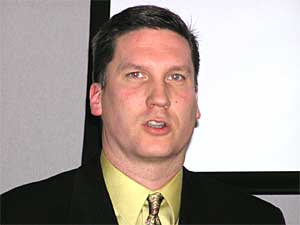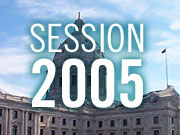January 25, 2005
 |
| Human Services Commissioner Kevin Goodno says Minnesota is still providing adequate care. He says Minnesota is still one of the most generous states when it comes to health care coverage. (MPR Photo/Mark Zdechlik) |
St. Paul, Minn. — Gov. Pawlenty says the rapid growth of Minnesota's health care programs are consuming every other portion of the state budget. Pawlenty has recently started labeling programs such as MinnesotaCare, General Assistance Medical Care and Medical Assistance "welfare health care." He says it's important to get a handle on these subsidies.
"We have this explosion of welfare health care costs that is devouring our budget at a rate and pace and scope that is unsustainable," says Pawlenty. "It's not fair to the rest of the obligations and responsibilities we have."
The governor is quick to point out that the human services portion of his budget will still rise 15 percent over the next two years. But it won't rise fast enough to keep everyone eligible for state health insurance.
The governor is recommending cuts to MinnesotaCare, a state program that provides subsidized insurance to low income workers. Adults without children and parents who are on the higher end of the income scale would no longer be eligible for the program. Children would still be eligible.
Sen. Linda Berglin, DFL-Minneapolis, says Pawlenty's plan drastically eliminates health insurance for people who need it.
"Those jobs are just as important as my job," says Berglin. "The governor doesn't give speeches to banquets and luncheons without having people in the kitchen doing the work. And those people are earning an income, doing a good job, and they don't have health care and he's cutting them off."
State figures say 27,000 Minnesotans will no longer be eligible for MinnesotaCare under Pawlenty's plan by next year.
But the governor says there would still be a safety net for people who desperately need care. He says anyone cut off from MinnesotaCare would be eligible for General Assistance Medical Care, or GAMC. That's a program that provides coverage for people who make no more than $600 per month.
Pawlenty says anyone who was on MinnesotaCare would be eligible for GAMC if their health care costs dropped their income to GAMC levels. The Children's Defense Fund's Jim Koppel says that means parents who make about $50,000 dollars a year would have to spend $36,000 a year in health care costs to be eligible for insurance.
"You need a catastrophic illness and you have to go broke -- then they pay your hospital bills. Your family is devastated, your health care is devastated and you're on a public program at that point. This is an investment in a failure of health. This is not an investment in health care," says Koppel.
Bruce Rueben with the Minnesota Hospital Association says he's concerned that those folks would probably forego insurance unless they needed it. He says they'd likely get sicker and end up in hospital emergency rooms.
"It puts those families at risk and those people at risk because they're now seeking health care in a haphazard way, only when they're really really sick. They don't get access to all of the preventive care, all of the early treatment and diagnostics," says Reuben.
Others are concerned that Pawlenty is using money from a fund that pays for MinnesotaCare to pay for GAMC, and other non-health programs that used to be paid for by state taxes.
Dr. Terry Cahill with United Clinics in Faribault County He says he and other members of the Minnesota Medical Association are disappointed that Pawlenty is taking money that is meant to increase health care coverage to fund other programs.
"We keep trying to take the money that was designed to expand coverage, and using it to meet other obligations that previously have been met by the general fund," says Cahill.
Human Services Commissioner Kevin Goodno says despite all of the criticism, Minnesota is still providing adequate care. He says Minnesota is still one of the most generous states when it comes to health care coverage.
"Even with these proposed changes, these programs -- comparing them to our neighboring states for comparable programs -- they're still the most generous programs of all the neighboring states and all of the states in the region," says Goodno.
Goodno says the governor's budget does increase funding for people in nursing homes, and increases funds to end homelessness.






